New Testament Canon Lesson 2
Chris Knepp
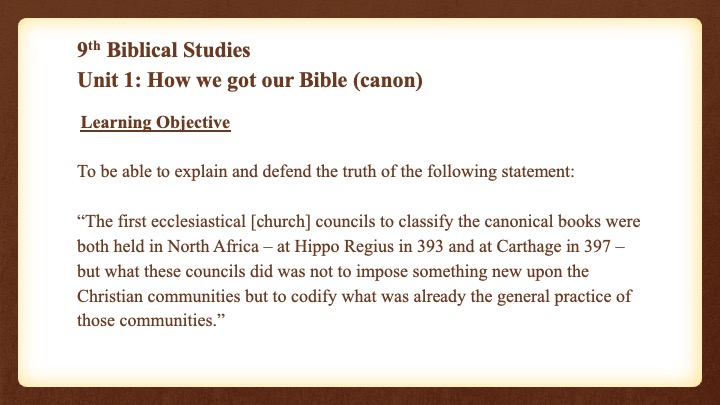
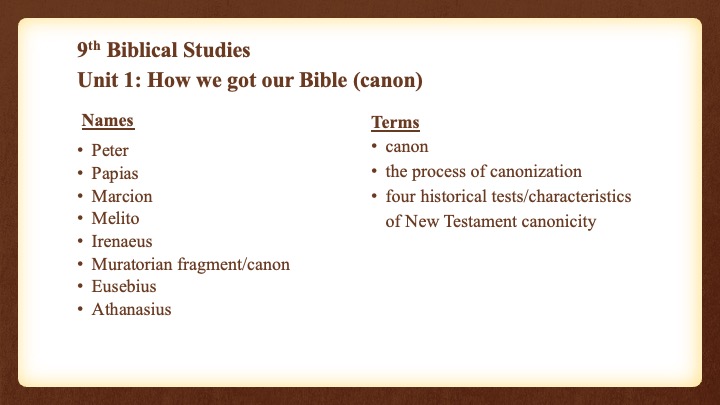
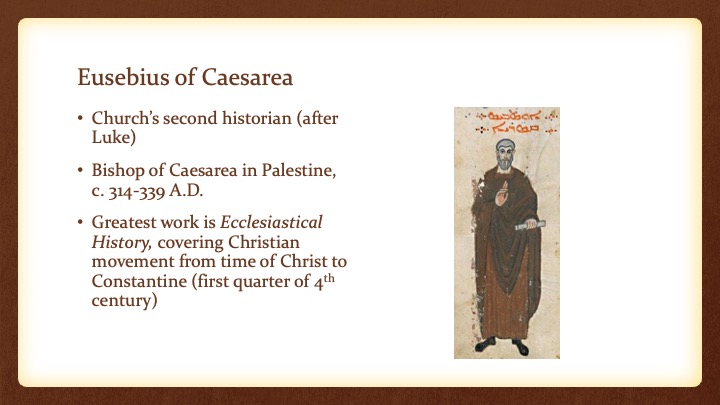
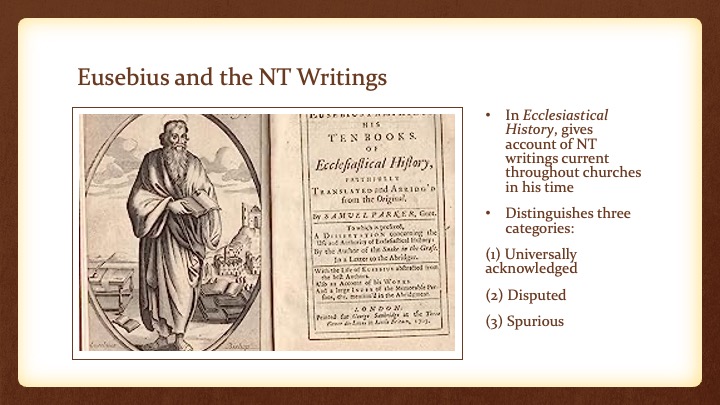
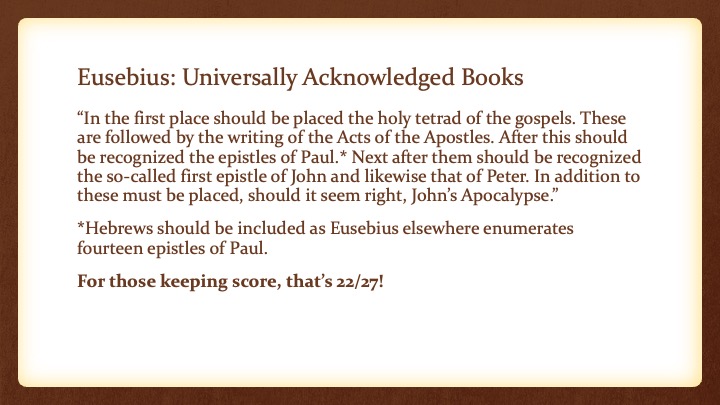
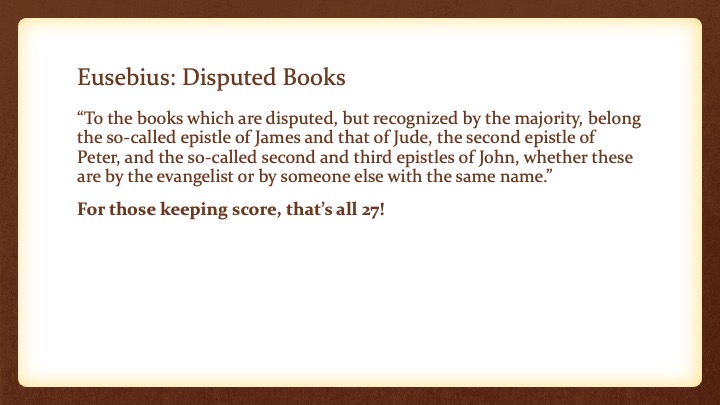
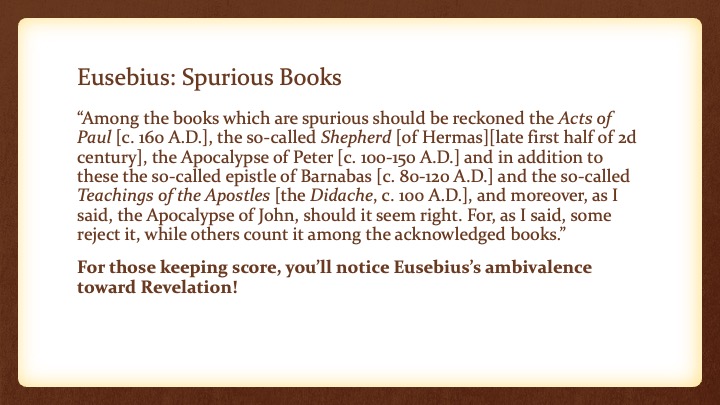
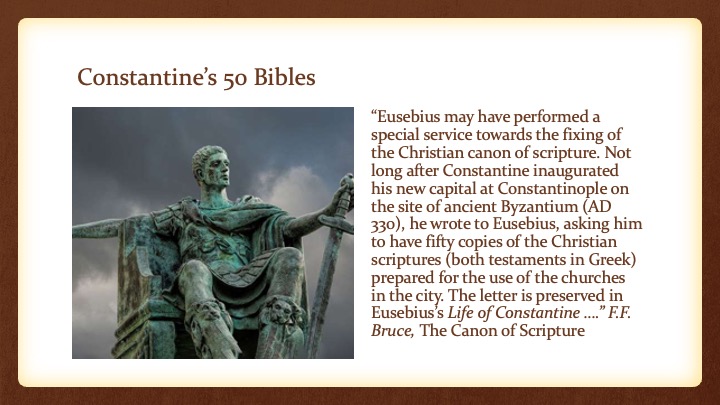
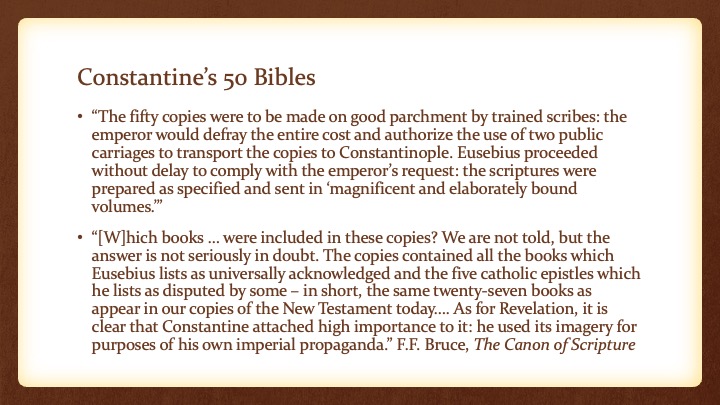
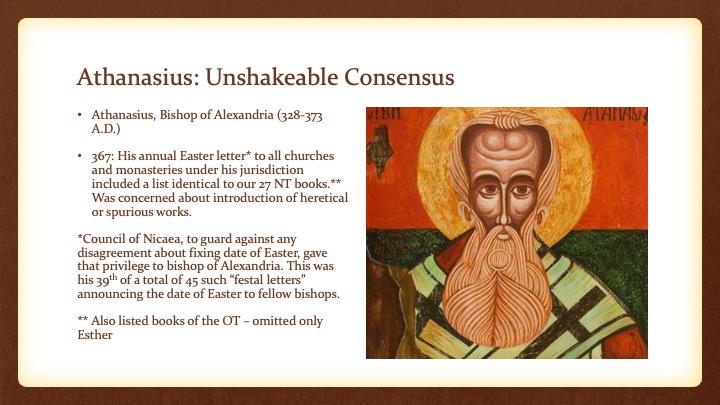
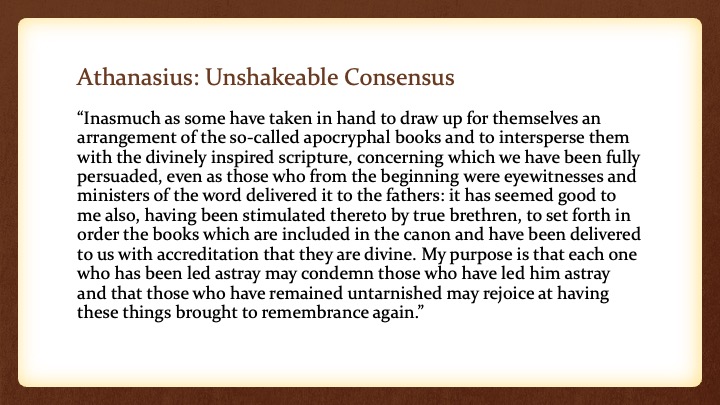
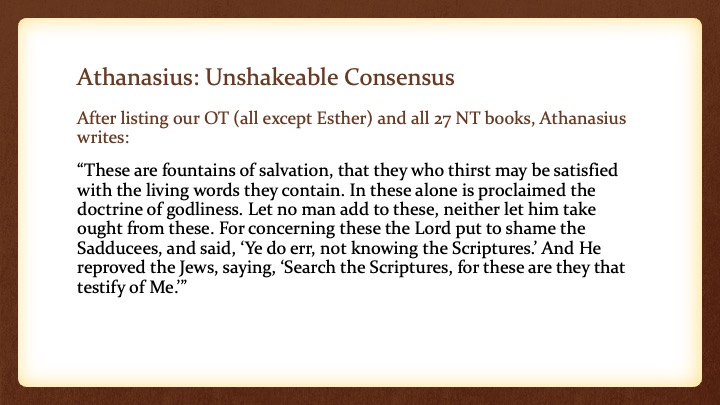
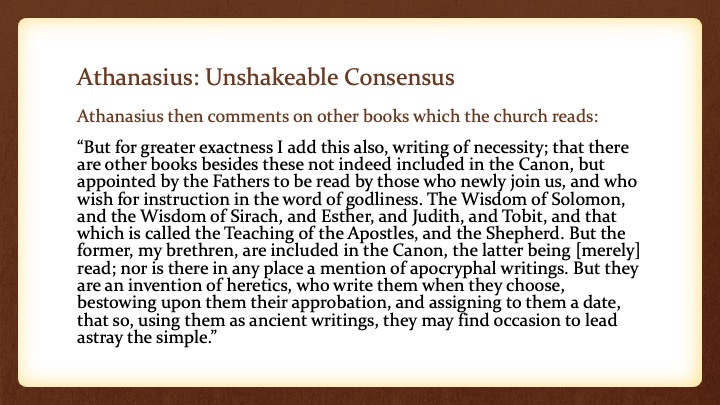
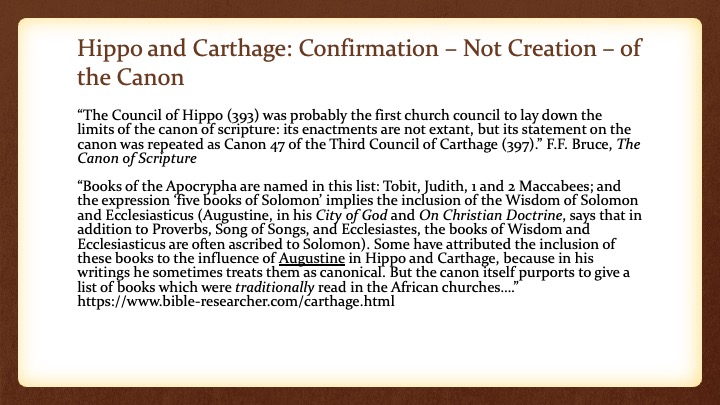
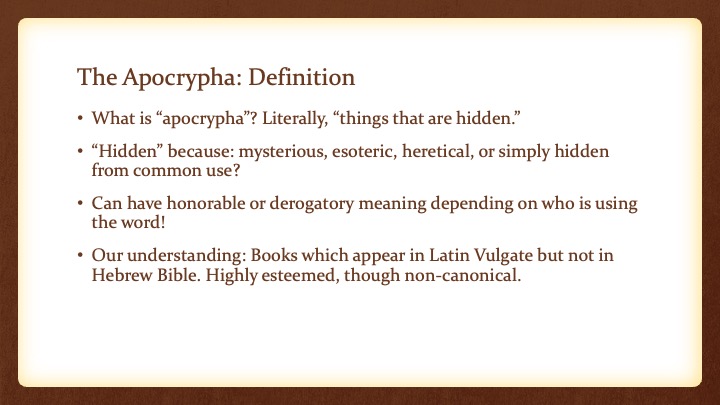
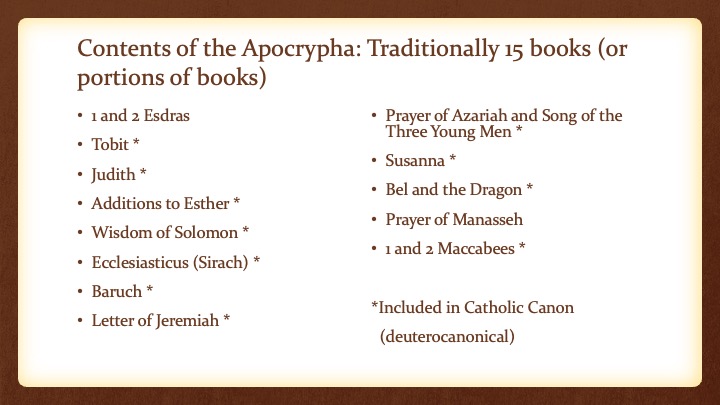
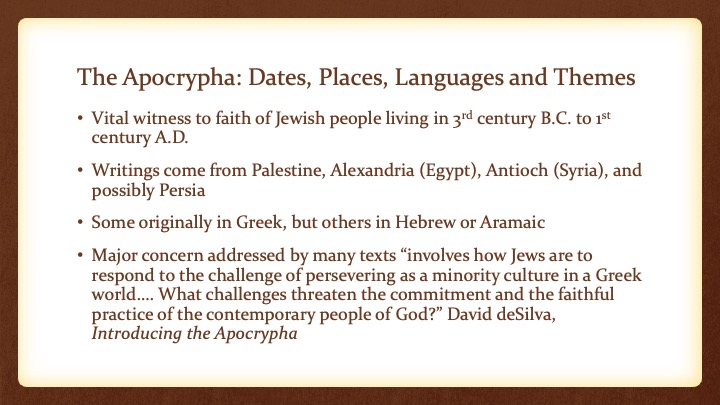
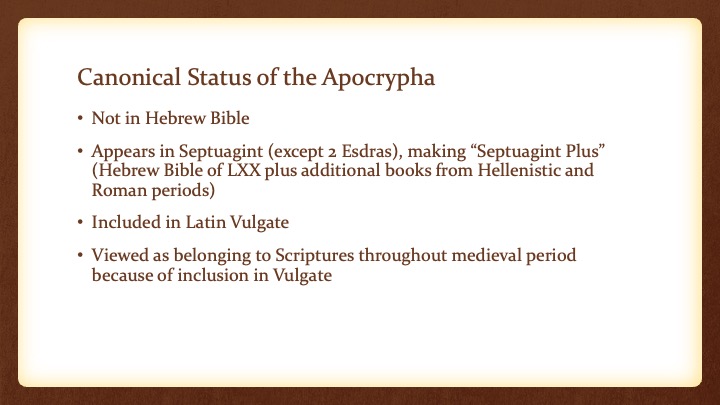
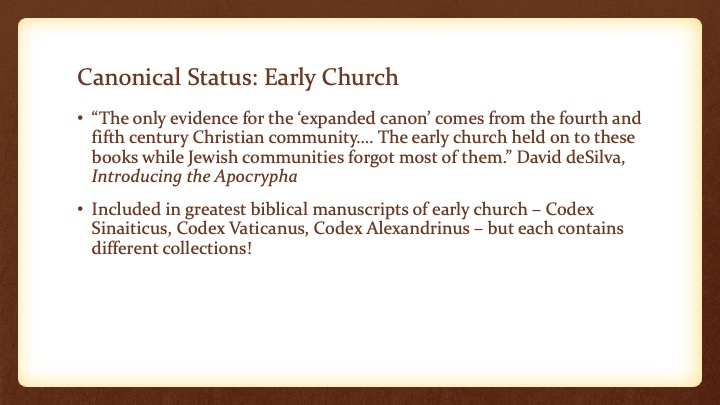
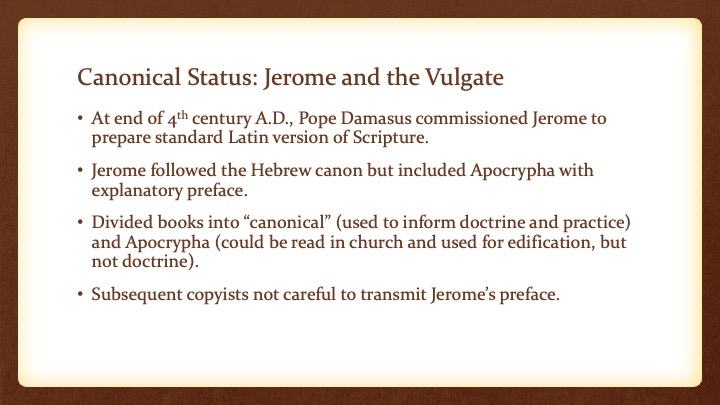
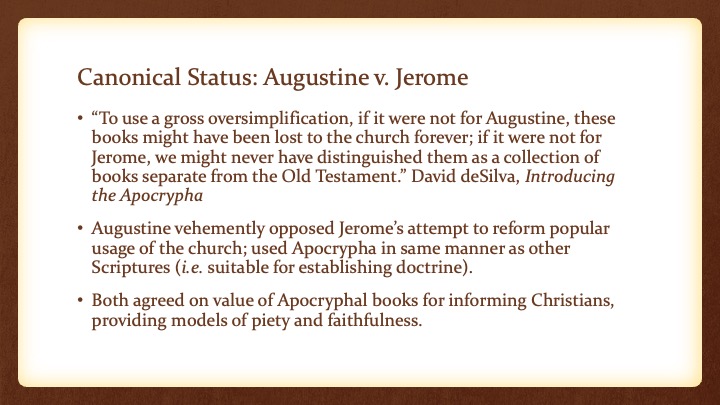
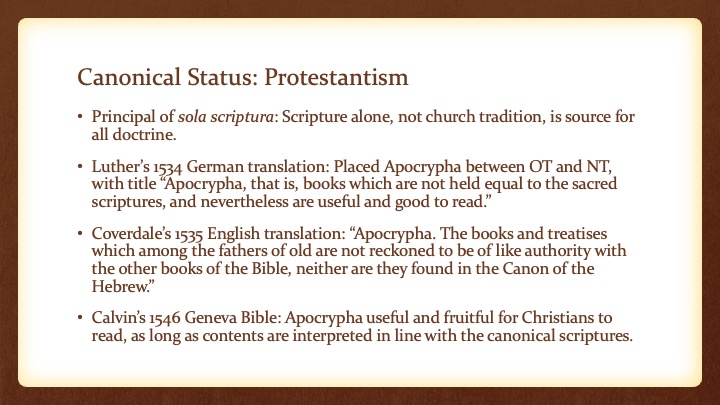
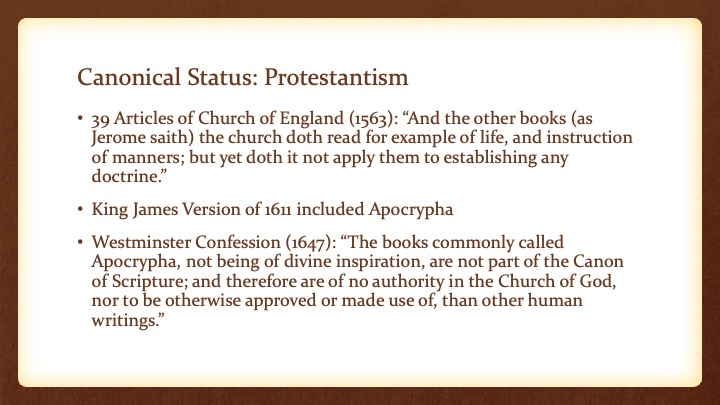
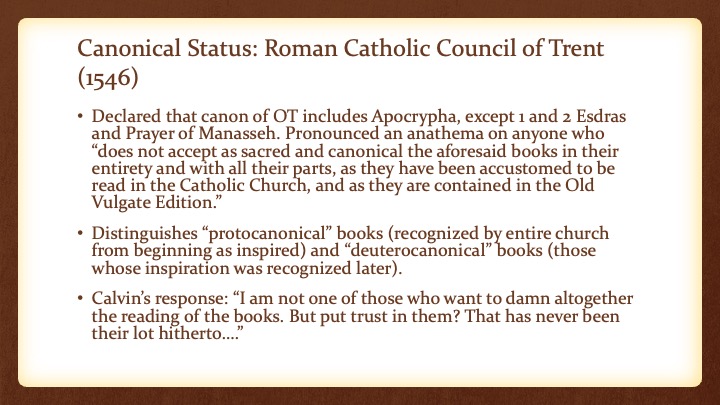
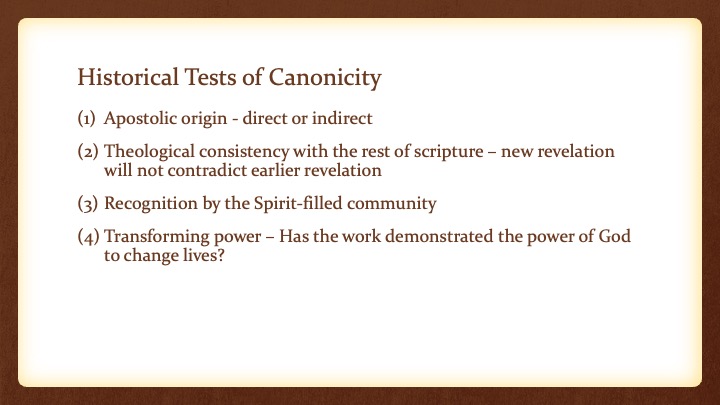
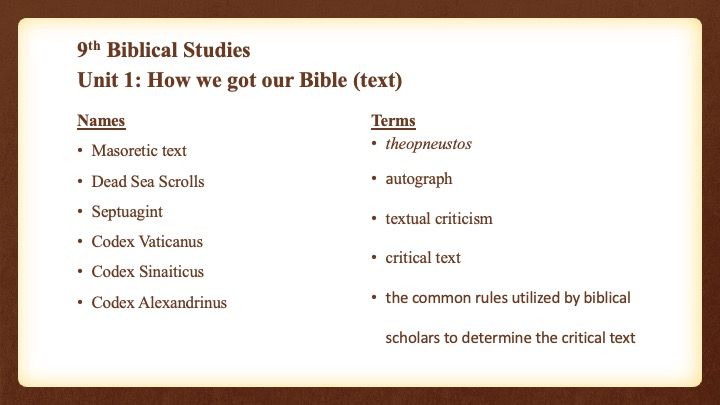

Text For NT Canon Lesson 2
Text for NT Canon Lesson 2
Learning Objective
To be able to explain and defend the truth of the following statement:
“The first ecclesiastical [church] councils to classify the canonical books were both held in North Africa – at Hippo Regius in 393 and at Carthage in 397 – but what these councils did was not to impose something new upon the Christian communities but to codify what was already the general practice of those communities.”
Names
Peter
Papias
Marcion
Melito
Irenaeus
Muratorian fragment/canon
Eusebius
Athanasius
Terms
canon
the process of canonization
four historical tests/characteristics of New Testament canonicity
Eusebius of Caesarea
Church’s second historian (after Luke)
Bishop of Caesarea in Palestine, c. 314-339 A.D.
Greatest work is Ecclesiastical History, covering Christian movement from time of Christ to Constantine (first quarter of 4th century)
Eusebius: Universally Acknowledged Books
“In the first place should be placed the holy tetrad of the gospels. These are followed by the writing of the Acts of the Apostles. After this should be recognized the epistles of Paul.* Next after them should be recognized the so-called first epistle of John and likewise that of Peter. In addition to these must be placed, should it seem right, John’s Apocalypse.”
*Hebrews should be included as Eusebius elsewhere enumerates fourteen epistles of Paul.
For those keeping score, that’s 22/27!
Eusebius: Disputed Books
“To the books which are disputed, but recognized by the majority, belong the so-called epistle of James and that of Jude, the second epistle of Peter, and the so-called second and third epistles of John, whether these are by the evangelist or by someone else with the same name.”
For those keeping score, that’s all 27!
Eusebius: Spurious Books“Among the books which are spurious should be reckoned the Acts of Paul [c. 160 A.D.], the so-called Shepherd [of Hermas][late first half of 2d century], the Apocalypse of Peter [c. 100-150 A.D.] and in addition to these the so-called epistle of Barnabas [c. 80-120 A.D.] and the so-called Teachings of the Apostles [the Didache, c. 100 A.D.], and moreover, as I said, the Apocalypse of John, should it seem right. For, as I said, some reject it, while others count it among the acknowledged books.”
For those keeping score, you’ll notice Eusebius’s ambivalence toward Revelation!
Constantine’s 50 Bibles
“Eusebius may have performed a special service towards the fixing of the Christian canon of scripture. Not long after Constantine inaugurated his new capital at Constantinople on the site of ancient Byzantium (AD 330), he wrote to Eusebius, asking him to have fifty copies of the Christian scriptures (both testaments in Greek) prepared for the use of the churches in the city. The letter is preserved in Eusebius’s Life of Constantine ….” F.F. Bruce, The Canon of Scripture
Constantine’s 50 Bibles
“The fifty copies were to be made on good parchment by trained scribes: the emperor would defray the entire cost and authorize the use of two public carriages to transport the copies to Constantinople. Eusebius proceeded without delay to comply with the emperor’s request: the scriptures were prepared as specified and sent in ‘magnificent and elaborately bound volumes.’”
“[W]hich books … were included in these copies? We are not told, but the answer is not seriously in doubt. The copies contained all the books which Eusebius lists as universally acknowledged and the five catholic epistles which he lists as disputed by some – in short, the same twenty-seven books as appear in our copies of the New Testament today…. As for Revelation, it is clear that Constantine attached high importance to it: he used its imagery for purposes of his own imperial propaganda.” F.F. Bruce, The Canon of Scripture
Athanasius: Unshakeable Consensus
Athanasius, Bishop of Alexandria (328-373 A.D.)
367: His annual Easter letter* to all churches and monasteries under his jurisdiction included a list identical to our 27 NT books.** Was concerned about introduction of heretical or spurious works.
*Council of Nicaea, to guard against any disagreement about fixing date of Easter, gave that privilege to bishop of Alexandria. This was his 39th of a total of 45 such “festal letters” announcing the date of Easter to fellow bishops.
** Also listed books of the OT – omitted only Esther
Athanasius: Unshakeable Consensus
“Inasmuch as some have taken in hand to draw up for themselves an arrangement of the so-called apocryphal books and to intersperse them with the divinely inspired scripture, concerning which we have been fully persuaded, even as those who from the beginning were eyewitnesses and ministers of the word delivered it to the fathers: it has seemed good to me also, having been stimulated thereto by true brethren, to set forth in order the books which are included in the canon and have been delivered to us with accreditation that they are divine. My purpose is that each one who has been led astray may condemn those who have led him astray and that those who have remained untarnished may rejoice at having these things brought to remembrance again.”
Athanasius: Unshakeable Consensus
After listing our OT (all except Esther) and all 27 NT books, Athanasius writes:
“These are fountains of salvation, that they who thirst may be satisfied with the living words they contain. In these alone is proclaimed the doctrine of godliness. Let no man add to these, neither let him take ought from these. For concerning these the Lord put to shame the Sadducees, and said, ‘Ye do err, not knowing the Scriptures.’ And He reproved the Jews, saying, ‘Search the Scriptures, for these are they that testify of Me.’”
Athanasius: Unshakeable Consensus
Athanasius then comments on other books which the church reads:
“But for greater exactness I add this also, writing of necessity; that there are other books besides these not indeed included in the Canon, but appointed by the Fathers to be read by those who newly join us, and who wish for instruction in the word of godliness. The Wisdom of Solomon, and the Wisdom of Sirach, and Esther, and Judith, and Tobit, and that which is called the Teaching of the Apostles, and the Shepherd. But the former, my brethren, are included in the Canon, the latter being [merely] read; nor is there in any place a mention of apocryphal writings. But they are an invention of heretics, who write them when they choose, bestowing upon them their approbation, and assigning to them a date, that so, using them as ancient writings, they may find occasion to lead astray the simple.”
The Apocrypha: Definition
What is “apocrypha”? Literally, “things that are hidden.”
“Hidden” because: mysterious, esoteric, heretical, or simply hidden from common use?
Can have honorable or derogatory meaning depending on who is using the word!
Our understanding: Books which appear in Latin Vulgate but not in Hebrew Bible. Highly esteemed, though non-canonical.
Contents of the Apocrypha: Traditionally 15 books (or portions of books)
1 and 2 Esdras
Tobit *
Judith *
Additions to Esther *
Wisdom of Solomon *
Ecclesiasticus (Sirach) *
Baruch *
Letter of Jeremiah *
Prayer of Azariah and Song of the Three Young Men *
Susanna *
Bel and the Dragon *
Prayer of Manasseh
1 and 2 Maccabees *
*Included in Catholic Canon
(deuterocanonical)
The Apocrypha: Dates, Places, Languages and Themes
Vital witness to faith of Jewish people living in 3rd century B.C. to 1st century A.D.
Writings come from Palestine, Alexandria (Egypt), Antioch (Syria), and possibly Persia
Some originally in Greek, but others in Hebrew or Aramaic
Major concern addressed by many texts “involves how Jews are to respond to the challenge of persevering as a minority culture in a Greek world…. What challenges threaten the commitment and the faithful practice of the contemporary people of God?” David deSilva, Introducing the Apocrypha
Canonical Status of the Apocrypha
Not in Hebrew Bible
Appears in Septuagint (except 2 Esdras), making “Septuagint Plus” (Hebrew Bible of LXX plus additional books from Hellenistic and Roman periods)
Included in Latin Vulgate
Viewed as belonging to Scriptures throughout medieval period because of inclusion in Vulgate
Canonical Status: Early Church
“The only evidence for the ‘expanded canon’ comes from the fourth and fifth century Christian community…. The early church held on to these books while Jewish communities forgot most of them.” David deSilva, Introducing the Apocrypha
Included in greatest biblical manuscripts of early church – Codex Sinaiticus, Codex Vaticanus, Codex Alexandrinus – but each contains different collections!
Canonical Status: Jerome and the Vulgate
At end of 4th century A.D., Pope Damasus commissioned Jerome to prepare standard Latin version of Scripture.
Jerome followed the Hebrew canon but included Apocrypha with explanatory preface.
Divided books into “canonical” (used to inform doctrine and practice) and Apocrypha (could be read in church and used for edification, but not doctrine).
Subsequent copyists not careful to transmit Jerome’s preface.
Canonical Status: Augustine v. Jerome
“To use a gross oversimplification, if it were not for Augustine, these books might have been lost to the church forever; if it were not for Jerome, we might never have distinguished them as a collection of books separate from the Old Testament.” David deSilva, Introducing the Apocrypha
Augustine vehemently opposed Jerome’s attempt to reform popular usage of the church; used Apocrypha in same manner as other Scriptures (i.e. suitable for establishing doctrine).
Both agreed on value of Apocryphal books for informing Christians, providing models of piety and faithfulness.
Canonical Status: Protestantism
Principal of sola scriptura: Scripture alone, not church tradition, is source for all doctrine.
Luther’s 1534 German translation: Placed Apocrypha between OT and NT, with title “Apocrypha, that is, books which are not held equal to the sacred scriptures, and nevertheless are useful and good to read.”
Coverdale’s 1535 English translation: “Apocrypha. The books and treatises which among the fathers of old are not reckoned to be of like authority with the other books of the Bible, neither are they found in the Canon of the Hebrew.”
Calvin’s 1546 Geneva Bible: Apocrypha useful and fruitful for Christians to read, as long as contents are interpreted in line with the canonical scriptures.
Canonical Status: Protestantism
39 Articles of Church of England (1563): “And the other books (as Jerome saith) the church doth read for example of life, and instruction of manners; but yet doth it not apply them to establishing any doctrine.”
King James Version of 1611 included Apocrypha
Westminster Confession (1647): “The books commonly called Apocrypha, not being of divine inspiration, are not part of the Canon of Scripture; and therefore are of no authority in the Church of God, nor to be otherwise approved or made use of, than other human writings.”
Canonical Status: Roman Catholic Council of Trent (1546)
Declared that canon of OT includes Apocrypha, except 1 and 2 Esdras and Prayer of Manasseh. Pronounced an anathema on anyone who “does not accept as sacred and canonical the aforesaid books in their entirety and with all their parts, as they have been accustomed to be read in the Catholic Church, and as they are contained in the Old Vulgate Edition.”
Distinguishes “protocanonical” books (recognized by entire church from beginning as inspired) and “deuterocanonical” books (those whose inspiration was recognized later).
Calvin’s response: “I am not one of those who want to damn altogether the reading of the books. But put trust in them? That has never been their lot hitherto….”
Historical Tests of Canonicity
(1) Apostolic origin - direct or indirect
(2) Theological consistency with the rest of scripture – new revelation will not contradict earlier revelation
(3) Recognition by the Spirit-filled community
(4) Transforming power – Has the work demonstrated the power of God to change lives?
Learning Objective
To be able to complete the following statement using the names and terms listed above:
“Even though we do not have any of the autographs, I have confidence that the Bible I read accurately conveys the original text of the scriptures because….”